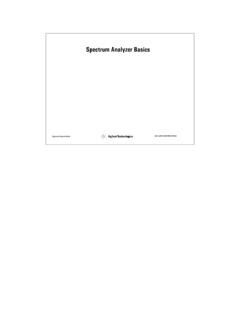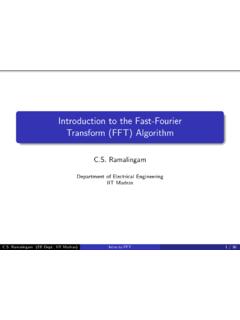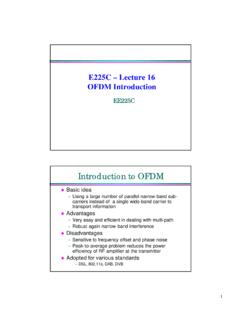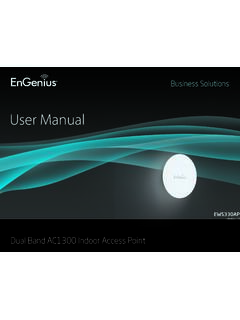Transcription of MIMO-OFDM
1 mimo -OFDMWIRELESSCOMMUNICATIONSWITH MATLAB mimo -OFDMWIRELESSCOMMUNICATIONSWITH MATLAB Yong Soo ChoChung-Ang University, Republic of KoreaJaekwon KimYonsei University, Republic of KoreaWon Young YangChung-Ang University, Republic of KoreaChung G. KangKorea University, Republic of KoreaCopyright 2010 John Wiley & Sons (Asia) Pte Ltd, 2 Clementi Loop, # 02-01,Singapore 129809 Visit our Home Page on Rights Reserved. No part of this publication may be reproduced, stored in a retrieval system or transmitted in anyform or by any means, electronic, mechanical, photocopying, recording, scanning, or otherwise, except as expresslypermitted by law, without either the prior written permission of the Publisher, or authorization through payment ofthe appropriate photocopy fee to the Copyright Clearance Center. Requests for permission should be addressed to thePublisher, John Wiley & Sons (Asia) Pte Ltd, 2 Clementi Loop, #02-01, Singapore 129809, tel: 65-64632400,fax: 65-64646912, email: used by companies to distinguish their products are often claimed as trademarks.
2 All brand names and productnames used in this book are trade names, service marks, trademarks or registered trademarks of their respective Publisher is not associated with any product or vendor mentioned in this book. All trademarks referred to in the text of thispublication are the property of their respective is a trademark of The MathWorks, Inc. and is used with permission. The MathWorks does not warrant theaccuracy of the text or exercises in this book. This book s use or discussion of MATLAB software or related products does notconstitute endorsement or sponsorship by The MathWorks of a particular pedagogical approach or particular use of theMATLAB publication is designed to provide accurate and authoritative information in regard to the subject matter is sold on the understanding that the Publisher is not engaged in rendering professional services. If professional adviceor other expert assistance is required, the services of a competent professional should be Wiley Editorial OfficesJohn Wiley & Sons, Ltd, The Atrium, Southern Gate, Chichester, West Sussex, PO19 8SQ, UKJohn Wiley & Sons Inc.
3 , 111 River Street, Hoboken, NJ 07030, USAJ ossey-Bass, 989 Market Street, San Francisco, CA 94103-1741, USAW iley-VCH Verlag GmbH, Boschstrasse 12, D-69469 Weinheim, GermanyJohn Wiley & Sons Australia Ltd, 42 McDougall Street, Milton, Queensland 4064, AustraliaJohn Wiley & Sons Canada Ltd, 5353 Dundas Street West, Suite 400, Toronto, ONT, M9B 6H8, CanadaWiley also publishes its books in a variety of electronic formats. Some content that appears in print may not be availablein electronic of Congress Cataloging-in-Publication DataMIMO- ofdm wireless communications with MATLAB / Yong Soo Cho .. [et al.].p. bibliographical references and 978-0-470-82561-7 (cloth)1. Orthogonal frequency division multiplexing. 2. mimo systems. 3. MATLAB . I. Cho, Yong dc222010013156 Print ISBN: 978-0-470-82561-7ePDF ISBN: 978-0-470-82562-4oBook ISBN: 978-0-470-82563-1 Typeset in 10/12pt Times by Thomson Digital, Noida, book is printed on acid-free paper responsibly manufactured from sustainable forestry in which at least two trees areplanted for each one used for paper our parents and familieswho love and support usandto our studentswho enriched our knowledgeContentsPrefacexiiiLimits of Liability and Disclaimer of Warranty of Softwarexv1 The Wireless Channel: Propagation and Large-Scale General Path Loss Okumura/Hata IEEE Small-Scale Parameters for Small-Scale Time-Dispersive vs.
4 Frequency-Dispersive Statistical Characterization and Generationof Fading Channel192 SISO Channel Indoor Channel General Indoor Channel IEEE Channel Saleh-Valenzuela (S-V) Channel UWB Channel Outdoor Channel FWGN Jakes Ray-Based Channel Frequency-Selective Fading Channel SUI Channel Model653 mimo Channel Statistical mimo Spatial PAS I-METRA mimo Channel Statistical Model of Correlated mimo Fading Generation of Correlated mimo Channel I-METRA mimo Channel 3 GPP mimo Channel SCM mimo Channel SCM Link-Level Channel SCM Link-Level Channel Spatial Correlation of Ray-Based Channel Model1054 Introduction to Single-Carrier vs. Multi-Carrier Single-Carrier Multi-Carrier Single-Carrier vs. Multi-Carrier Basic Principle of ofdm Modulation and ofdm Guard ofdm Guard BER of ofdm Water-Filling Algorithm for Frequency-DomainLink Coded OFDMA: Multiple Access Extensions of Resource Allocation Subchannel Allocation Resource Allocation Duplexing1505 Synchronization for Effect of Effect of Effect of Integer Carrier Frequency Offset (IFO) Effect of Fractional Carrier Frequency Offset (FFO)
5 Estimation Techniques for Time-Domain Estimation Techniques for Frequency-Domain Estimation Techniques for Estimation Techniques for Time-Domain Estimation Techniques for Frequency-Domain Estimation Techniques for Effect of Sampling Clock Effect of Phase Offset in Sampling Effect of Frequency Offset in Sampling Compensation for Sampling Clock Synchronization in Cellular Downlink Uplink Synchronization1836 Channel Pilot Block Comb Lattice Training Symbol-Based Channel LS Channel MMSE Channel DFT-Based Channel Decision-Directed Channel Advanced Channel Estimation Channel Estimation Using a Superimposed Channel Estimation in Fast Time-Varying EM Algorithm-Based Channel Blind Channel Estimation2067 PAPR Introduction to Definition of Distribution of ofdm PAPR and Clipping and PAPR Reduction Clipping and PAPR Reduction Selective Partial Transmit Tone Tone DFT Spreading2418 Inter-Cell Interference Mitigation Inter-Cell Interference Coordination Fractional Frequency Soft Frequency Flexible Fractional Frequency Dynamic Channel Inter-Cell Interference Randomization Cell-Specific Cell-Specific Frequency-Hopping Random Subcarrier Inter-Cell Interference Cancellation Interference Rejection Combining IDMA Multiuser Detection2629 mimo : Channel Useful Matrix Deterministic mimo Channel Channel Capacity when CSI is Knownto the Transmitter Channel Capacity when CSI is Not Available at theTransmitter Channel Capacity of SIMO and MISO Channel Capacity of Random mimo Channels27210 Antenna Diversity and Space-Time Coding Antenna Receive Transmit Space-Time Coding (STC).
6 System Pairwise Error Space-Time Code Space-Time Block Code (STBC) Alamouti Space-Time Generalization of Space-Time Block Decoding for Space-Time Block Space-Time Trellis Code30711 Signal Detection for Spatially Multiplexed mimo Linear Signal ZF Signal MMSE Signal OSIC Signal ML Signal Sphere Decoding QRM-MLD Lattice Reduction-Aided Lenstra-Lenstra-Lovasz (LLL) Application of Lattice Soft Decision for mimo Log-Likelihood-Ratio (LLR) for SISO LLR for Linear Detector-Based mimo LLR for mimo System with a Candidate Vector LLR for mimo System Using a LimitedCandidate Vector Set364 Appendix Derivation of Equation ( )37012 Exploiting Channel State Information at theTransmitter Channel Estimation on the Transmitter Using Channel CSI Precoded Precoded Spatial-Multiplexing Antenna Selection Optimum Antenna Selection Complexity-Reduced Antenna Antenna Selection for OSTBC39013 Multi-User Mathematical Model for Multi-User mimo Channel Capacity of Multi-User mimo Capacity of Capacity of Transmission Methods for Broadcast Channel Block Dirty Paper Coding (DPC) Tomlinson-Harashima Precoding412 References419 Index431 ContentsxiPrefaceMIMO- ofdm is a key technology for next-generation cellular communications (3 GPP-LTE,Mobile WiMAX, IMT-Advanced) as well as wireless LAN (IEEE , IEEE ),wireless PAN (MB- ofdm ), and broadcasting (DAB, DVB, DMB).
7 This book provides acomprehensive introduction to the basic theory and practice of wireless channel modeling, ofdm , and mimo , with MATLAB programs to simulate the underlying techniques onMIMO- ofdm systems. This book is primarily designed for engineers and researchers who areinterested in learning various MIMO-OFDM techniques and applying them to wirelesscommunications. It can also be used as a textbook for graduate courses or senior-levelundergraduate courses on advanced digital communications. The readers are assumed to havea basic knowledge on digital communications, digital signal processing, communicationtheory, signals and systems, as well as probability and random first aim of this book is to help readers understand the concepts, techniques, andequations appearing in the field of MIMO-OFDM communication, while simulating varioustechniques used in MIMO-OFDM systems. Readers are recommended to learn some basicusage of MATLAB that is available from the MATLAB help function or the on-linedocuments at the website However, they are not requiredto be an expert on MATLAB since most programs in this book have been composed carefullyand completely, so that they can be understood in connection with related/referred readers are expected to be familiar with the MATLAB software while trying to use ormodify the MATLAB codes.
8 The second aim of this book is to make even a novice at bothMATLAB and MIMO-OFDM become acquainted with MIMO-OFDM as well asMATLAB , while running the MATLAB program on his/her computer. The authors hopethat this book can be used as a reference for practicing engineers and students who want toacquire basic concepts and develop an algorithm on MIMO-OFDM using the MATLAB program. The features of this book can be summarized as follows:.Part I presents the fundamental concepts and MATLAB programs for simulation of wirelesschannel modeling techniques, including large-scale fading, small-scale fading, indoor andoutdoor channel modeling, SISO channel modeling, and mimo channel II presents the fundamental concepts and MATLAB programs for simulation of ofdm transmission techniques including ofdm basics, synchronization, channel estimation,peak-to-average power ratio reduction, and intercell interference III presents the fundamental concepts and MATLAB programs for simulation ofMIMO techniques including mimo channel capacity, space diversity and space-time codes,signal detection for spatially-multiplexed mimo systems, precoding and antenna selectiontechniques.
9 And multiuser mimo MATLAB programs are presented in a complete form so that the readers with noprogramming skill can run them instantly and focus on understanding the concepts andcharacteristics of MIMO-OFDM systems. The contents of this book are derived from theworksof many great scholars, engineers, researchers, all of whom are deeply would like to thank the reviewers for their valuable comments and suggestions, whichcontribute to enriching this book. We would like to express our heartfelt gratitude to colleaguesand former students who developed source programs: Dr. Won Gi Jeon, Dr. Kyung-Won Park,Dr. Mi-Hyun Lee, Dr. Kyu-In Lee, and Dr. Jong-Ho Paik. Special thanks should be given to who supported in preparing the typescript of the book: Kyung Soo Woo, Jung-WookWee, Chang Hwan Park, Yeong Jun Kim, Yo Han Ko, Hyun Il Yoo, Tae Ho Im, and many MSstudentsintheDigital alsothankthe editorialand production staffs, including Ms. Renee Lee of John Wiley & Sons (Asia) Pte Ltd andMs.
10 Aparajita Srivastava of Thomson Digital, for their kind, efficient, and files can be downloaded from of Liability and Disclaimerof Warranty of SoftwareThe authors and publisher of this book have used their best efforts and knowledge in preparingthis book as well as developing the computer programs in it. However, they make no warranty ofany kind, expressed or implied, with regard to the programs or the documentation contained inthis book. Accordingly, they shall not be liable for any incidental or consequential damages inconnection with, or arising out of, the readers use of, or reliance upon, the material in this reader is expressly warned to consider and adopt all safety precautions that might beindicated by the activities herein and to avoid all potential hazards. By following theinstructions contained herein, the reader willingly assumes all risks in connection with Wireless Channel: Propagationand FadingThe performance of wireless communication systems is mainly governed by the wirelesschannel environment.









